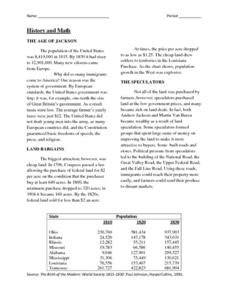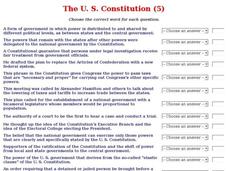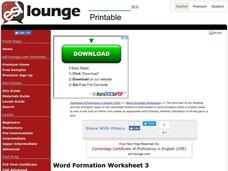Curated OER
Types of Government
In this types of government worksheet, students write the advantages and disadvantages and countries that follow these governments. Students do this for 7 different types of government.
Curated OER
Government & Politics: Chapter 1
In this United States history worksheet, middle schoolers reference their textbook to answer 18 fill in the blank questions and 8 short answer questions regarding different types of government.
Curated OER
Why Do Governments Exist? Locke, Hobbes, Montesquieu, and Rousseau
Here is a great secondary source reading that includes the primary ideas and philosophies of the famed Enlightenment philosophers: Thomas Hobbes, John Locke, Charles Montesquieu, and Jean-Jacques Rousseau. In additional to discussing...
Curated OER
Types of Government
In this government worksheet, 3rd graders read a selection about different types of governments and complete 7 matching, 3 fill in the blanks and 3 true / false questions.
The Alamo
Lorenzo de Zavala and José Antonio Navarro: Their Contributions to the Independence of Texas
Lorenzo de Zavala and José Antonio Navarro were both native Mexicans and leaders of the Texas Revolution, but with different backgrounds and careers. Compare and contrast the two influential men with a research assignment in which...
Digital History
The Age of Constitution Writing
Was the United States significantly more democratic in their governing structures and laws after the overthrow of British authorities? Compare and contrast summaries of the country's constitutions under British rule and after...
iCivics
The "Federal" in Federalism
How are states in the United States related to each other? Does the government bind them together? Do states have different governments? After reading about federal power as a whole group, your class members will participate in a...
Reading Through History
The Federalist Papers: Federalist Paper No. 51
How did Federalists feel about the federal government? Learners search for the answers in the Federalist Paper No. 51, which discusses the powers of the presidency. Then, they answer various questions to test for their comprehension of...
K12 Reader
What Glaciers Leave Behind
Glaciers may seem distant and stationary, but they are huge deposits of moving ice that have made changes to the earth's surface. Your pupils can learn about the different types of impressions left by glaciers by reading the short...
Bismarck Public Schools
History & Math of the 1830s
Using this interdisciplinary instructional activity, your young historians will have the opportunity to practice their math skills while learning about the drastic population increase in the United States during the presidency of Andrew...
Curated OER
End of WWI: The Treaty of Versailles
After learning about the causes and closure of WWI, hand out this resource on that outlines the differences between Wilson's 14 Point Plan and the Treaty of Versailles. The class reads the information provided then analyzes two political...
Curated OER
The U. S. Constitution (5)
In this online interactive American history worksheet, students answer 17 fill in the blank questions regarding the U. S. Constitution. Students may submit their answers to be scored.
Roy Rosenzweig Center for History and New Media
Investigating the Declaration of Independence
Teach your class about the Declaration of Independence while giving them practice working as a team. The resource breaks participants into groups and has them answer questions about specific grievances from the Declaration of...
Curated OER
Word Formation
In this word formation instructional activity, students fill in the spaces in six sentences with the base word given in bold in its correct form.
Auto English
First Conditional Tense
Helpful for English language learners as well as English speakers, this worksheet focuses on the conditional tense. The picture chart at the top of the page helps to explain that a conditional phrase can be formed two different...
Curated OER
Food Comparison PDF
In this health worksheet, students are led through lessons to become familiar with the dietary recommendations of the government.
Curated OER
Party Time!
In this discussion prompts worksheet, students, with a partner, discuss seven party phrases, use those phrases in seven sentences, define party in six different scenarios and start a conversation with ten key questions.
Curated OER
Leadership
Learning about leadership, and different styles can be an important step toward understanding government and local organizations. By participating in a survey to evaluate leadership styles, involving 60 questions, learners get a better...
DC Vote
One Kid, One Vote
Learn about why the citizens of Washington, D.C. feel unrepresented in Congress with an article about D.C voting rights. Individuals read about the movement toward congressional representation in Washington, D.C., before...
Curated OER
Ideas in Action
In this United States history learning exercise, students utilize a word bank of 10 terms or phrases to answer 10 fill in the blank questions pertaining to ideals that led to forming the U.S. Constitution. A short answer question is...
Curated OER
Transportation
In this transportation worksheet, students list the positive and negative aspects of different types of transportation. Students keep a diary of the different ways they used transportation for a week. This worksheet has 7 graphic...
Curated OER
American Revolution and Constitution Take-Home Assessment
In this early American history activity, learners draw diagrams of that feature the responsibilities of each of the 3 branches of the federal government and then create their own original visuals that highlight the formation of American...
Curated OER
American Revolution and Constitution Take Home Assessment
In this early American history worksheet, students create posters that feature the branches of government as established by the U.S. Constitution. Students also research founding ideals of the nation and use Venn diagrams to compare and...
Curated OER
Permutations
In this permutations worksheet, 6th graders solve and complete 5 different types of problems. First, they write a simple conceptual art plan with no more than 3 instructions. Then, students use graph paper and a pencil to draw a plan....

























